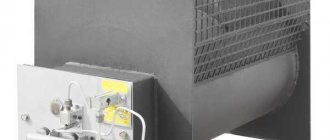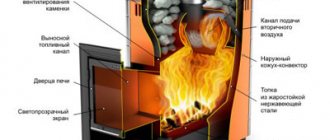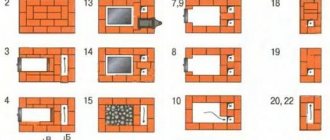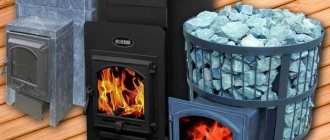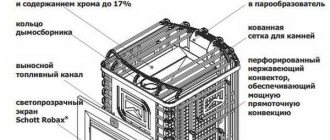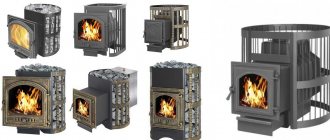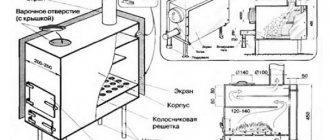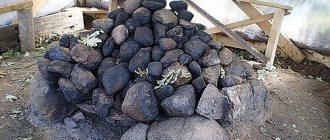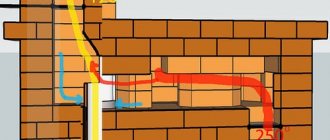In ancient times, Russian stoves stood in every peasant house. Such heating equipment certainly has many advantages. However, unfortunately, the Russian stove also has two rather serious drawbacks. Firstly, such equipment is not particularly economical. A lot of firewood needs to be prepared for a stove of this type. Secondly, during operation, such heating structures, unfortunately, warm up quite poorly below. Accordingly, the floor of the house remains cold. And the lower crowns begin to rot due to moisture condensation in the log house.
An alternative to the Russian stove
In ancient times, peasants, of course, knew about all these shortcomings of the most popular heating equipment in villages. However, the Russian stove always had more advantages than disadvantages. Therefore, it remained popular for a long time and no alternatives were sought. In addition, in ancient times there was much more firewood, as well as forests, than there is now. Accordingly, there was no particular need to save fuel and extend the service life of log houses.
We started thinking about replacing the Russian stove with a more economical model in Russia only after the revolution, during times of impoverishment of the population, general hunger, etc. In 1929, a special model of the Russian stove began to gain popularity in our country - the “teplushka”. This heating design was invented by the domestic engineer Podgorodnikov. To improve the Russian stove, he simply directed the gases from the cooking chamber downwards.
Subsequently, Podgorodnikov developed several types of hotbeds, differing in size, efficiency and location of the fireboxes. All these models made it possible, among other things, to select the operating mode and heating of individual parts.
Russian stove “Teplushka” 1270x1660 mm
The Russian Teplushka stove is one of the most functional heating and cooking stoves. With the help of such a stove, you can easily heat a relatively large living space, as well as prepare a lot of tasty and nutritious foods.Teplushka stoves come in different sizes and functionality. Some contain only a cooking chamber, an analogue of an ordinary Russian stove, and a lower heating chamber. Others also include a hob. Some stoves have separate fuel chambers for operating the stove in different modes. However, there are stoves in which the functions of the fuel chambers are combined and because of this they are easier to operate.
This project is based on the I.V. stove. Kuznetsov RTIK 5, which in turn is an improved version of the Teplushka-15 stove by I.S. Podgorodnikov. This stove is one of the most popular designs among the Russian Teplushkas.
The advantage of the oven is that it has several operating modes.
Firstly, this is a summer-style firebox. When the “summer” valve is open, hot gases can be sent directly into the pipe without heating the heating chamber.
Secondly, the firebox is winter-style. In this case, the gases warm up the heating chamber and only after that go into the pipe.
The next mode is the furnace for baking. The fuel burned in the fuel chamber heats the cooking chamber. In this case, the sealed door of the cooking chamber must be closed. In order for more heat to enter the cooking chamber, the grate located between the fuel and cooking chambers must be removed. After the oven is heated and the cooking chamber is warmed up, you can bake bread and cook food in it.
The “teplushka” can be heated in Russian style, with the cooking chamber door open. In this case, the fuel is placed on the grate in the bottom of the cooking chamber, and the combustion door of the firebox is opened. If the main smoke valve is closed and the ventilation valve is open, smoke will escape into the chimney through the open door of the cooking chamber. If you open the main valve and close the ventilation valve, until the smoke enters the room, the bottom of the stove will also warm up.
The oven has dimensions at the base of 1270x1660 mm.
Its height is 2 m 10 cm along the front side of the stove and 1 m 47 cm above the stove bench.
Heat output of at least 4500 W with double firing.
The size of the heated room is up to 35-40 m2.
If you would like more detailed information about this oven, please watch the instructional video provided here.
Basic information on this stove with a detailed description of each row is in the project.
To display the project in full screen mode, click on the icon located in the upper right corner of the project. In the window that opens, you can familiarize yourself with the project and download it in PDF .
Using the link below, you can download the project in the form of ZIP archive containing PDF and DOC versions of the project.
Download the project - Russian stove “Teplushka” 1270x1660 mm.
| Download | |
| Y.Disk | zip(pdf,doc) |
| DropBox | zip(pdf,doc) |
The oven was made:
Elena Zakharova
If there are broken links, please report this in the comments.
| < Previous | Next > |
Design Features
The main feature of Podgorodnikov’s heated vehicles is that they always have 2 chambers. The lower one is called the heating room, and the upper one is called the “crucible”. At the bottom of the “Teplushka” there is a water-heating box and pillars.
The fuel in such stoves is burned in a specially configured firebox located in the side wall. This part of the heating structure has a grate and a vent. However, there is no overlap in the firebox of such a stove. Gases from firewood in this type of equipment rise into the furnace and heat it, and then descend into the lower chamber. Next, the cooled smoke goes into the chimney.
If the house is warm, the owners have the opportunity to open a special damper when cooking. In this case, the gases will immediately go into the pipe. They will not get into the oven and it will remain cold.
Materials for production
The body and lining of the stove on the outside are made of refractory brick. The surface in contact with the fire is covered with basalt cardboard. If it is possible to process bricks using longitudinal cuts, you can use fireclay bricks.
Despite the high temperature in the lower chamber, special heat-resistant materials are not needed here. To protect the device from cracks, its lower part can be placed in a metal case.
The laying of the Podgorodnikov stove is carried out using a solution of sand and clay. The dosage is determined depending on the fat content of the clay. The easiest option is to buy a ready-made mixture for stove work.
It is worth taking care in advance about purchasing metal parts: hob, furnace doors, views and valves. It is advisable to choose cast iron ones - they increase the level of heat transfer.
Order and features of construction
The heated vehicles are laid using almost standard technology. The method of their construction is practically no different from the method of constructing a Russian stove. In any case, exclusively heat-resistant building materials are used for masonry of such structures. The order of the stove of Podgorodnikov’s heated vehicle may look, for example, as follows.
In addition to fireclay bricks and a heat-resistant clay-cement mixture, before starting to lay such a furnace, they purchase a grate, doors for two cleanings and a firebox, a water-heating box made of galvanized steel, etc. In any case, laying a heated stove is technologically a rather complicated procedure. Only a master who already has some experience in constructing stoves, including Russian ones, should take on this work.
Such furnaces are built on a solid foundation with waterproofing. In this case, the first row of masonry is made continuous. Further construction is carried out according to the chosen order.
Materials required for work
To build a stove, you need not only building materials, but also metal fittings:
- Door for the firebox. Dimensions 25x21 in quantity 1.
- Door for firebox dimensions 25x14 in quantity 3.
- Grate for a 25x25 stove - 1.
- Grate for floor grate 30x25 - 2.
- View - 1.
- Valve for summer - 1.
- Ventilation valve - 1.
- Damper for furnace 40x32 - 1.
- Cooker for two burners 71x41 - 1.
- Box for heating water - 1.
Construction material for Podgorodnikov’s heated stove:
- Regular brick - 800 pcs.
- Fire bricks – 80 pcs.
- Large nails 20-150 pcs.
- Steel corners of different sizes - 3 pcs.
- Metal strip - 7 pcs.
- Square washers - 10 pcs.
The heating stove has dimensions of 1 m 29 cm x 1 m 29 cm. The height inherent in the stoves is 32 rows of bricks, that is, 2 m 24 cm. Such an improved Russian stove can heat a room of 35 m².
The core of Podgorodnikov’s furnace is made of ready-made dry mortar “Plitonit”, which is fire-resistant. The furnace is made using a clay-cement mixture, which is mixed from cement, clay and sand in a ratio of 1:2:7.
Reviews about hot stoves
Owners of country houses with stove heating speak very well of almost all of Podgorodnikov’s models. Of course, such furnaces are quite complex in construction. However, they are also very convenient to use. There is no need to prepare too much firewood for this type of equipment. It’s easy to cook food in heated containers, and they heat the house perfectly.
In addition to brick, today there are also metal stoves with the same name on sale. Modern steel heated vehicles have also earned excellent reviews from the owners of country houses. The efficiency of such models is high and in terms of wood consumption, like brick stoves, they are considered economical.
Interesting Facts
At the moment, there are simply a huge number of modifications of the heating stoves of Podgorodnikov and other engineers. And each of these models has its own highlight. For example, in Teplushka-15, the most popular model today, the shelf in front of the furnace is also a stove. The result is a stove, behind the cooking surface of which there is a chamber covered by a damper.
The left firebox in this model is intended for using the stove, and the right one is for heating. At the same time, the gas circulation in Teplushka-15 is organized in such a way that the smoke warms up the entire structure of the stove, no matter how it is used. The dimensions of this model are quite large. However, drawings of a smaller copy of Teplushka-15 have also been developed.
The efficiency of stoves of this type is higher than Russian ones. It may be considered interesting that Podgorodnikov managed to achieve such a result only because he guessed to use the theory of free movement of gases when developing his models. Previously, all attempts by other engineers to improve the Russian stove ended in failure.
How to cook
The heating stove heats the premises, thus very efficiently. Such structures heat up quickly and take a long time to cool down. Heats, as already mentioned, are considered quite convenient in terms of cooking. But of course, you need to use the oven in this way correctly. It is believed that you should start cooking, stewing or frying in the chamber or on the stove of a hotpot only when it is well heated and only coals remain in the combustion chamber.
As in a conventional Russian oven, all dishes can be placed in the oven of such equipment at the same time. Their subsequent preparation will therefore proceed synchronously. However, it is recommended to bake bread separately in modern Russian Podgorodnikov ovens, as in the middle of the last century. In this case, it will turn out especially tasty and aromatic.
Brief biography of the creator
Hot stoves have been used to heat country houses for almost 100 years. Their creator I. S. Podgorodnikov was born in the city of Mogilev (Belarus), in 1886, into the family of a mechanic. After graduating from a real school, he entered the Technological Institute in St. Petersburg. After receiving a higher education diploma, Podgorodnikov got a job at the Putilov Shipyard.
During the revolution, the engineer tried to emigrate to Europe. It was difficult to do this then. To leave Russia, Podgorodnikov decided to walk to Crimea and try to board a ship. However, on the way, the engineer was detained by Red Army soldiers on suspicion of being a Denikin spy. Having found out that Podgorodnikov had nothing to do with the whites, he was simply taken out onto the road and released.
After this, Podgorodnikov changed his mind about traveling to Europe at risk to his life. Not believing his release, he went to Crimea, where he later married and got a job as a technician at a paper factory.
Even during his wanderings around the Central and southern parts of Russia for the purpose of emigration, Podgorodnikov drew attention to some imperfections of Russian stoves popular among peasants at that time. As an analytical person, he began to think about how to eliminate the shortcomings of such equipment.
Subsequently, Podgorodnikov shared his findings on this issue with Grum-Grzhimailo, an outstanding metallurgical engineer. Soon after this, he received an invitation to join one of the Moscow design institutes. Subsequently, Podgorodnikov’s main professional activity was the design of metal furnaces. However, in his free time he still continued to make bricks. The result of his efforts ultimately became a convenient and economical heating stove. Subsequently, it was this, essentially handicraft, model that won the enormous sympathy of the common people.
Bath stove
The material was found and prepared for publication by Grigory Luchansky
Source: I.S. Podgorodnikov. Bath stove. "Rural Construction", No. 7, 1978
We offer a stove of an original design, which was developed in 1932. In a bathhouse with such a stove there will be heat from the floor.
To ensure uniform heating and obtain greater efficiency from the stove, the firebox is placed not under the stone nozzle, but on the side and separated from it by a partition that does not reach the roof. The space under the stone nozzle communicates with the chimney; to enhance the draft in the pipe, the latter is connected by a channel directly to the firebox. To heat the water, water-heating pipes are placed under the furnace roof, communicating with a tank in which a shield with small holes is installed to break up the flowing stream of steam.
On the drawing; 1-1, 2-2, 3-3 - vertical sections in the places indicated on the horizontal section 4-4, 5-5 - vertical section indicated on the horizontal section 6-6.
The stove has a firebox a, located on the side of the partition that does not reach the arch; part of the firebox is occupied by a stone attachment lying on brick beams b (sections 1 and 3), which rest on columns c. On the side of the furnace there is a chimney d, on which a valve d is located (sections 3, 5). Through channel e (sections 5, 6), closed by valve g, the firebox is connected directly to the chimney. Under the roof of the furnace there are pipes 8 (sections 1, 2, 5), which are connected by pipes i and k (sections 1, 2) to a tank l for hot water installed in the attic. Hot gases from the firebox rise under the roof of the furnace and wash the water pipes. Since the gases have the highest temperature under the roof, the intensity of vapor formation in the pipes increases. This design allows the use of small diameter pipes. The steam formed in them rises into the tank through a pipe and, above the outlet of which, a shield with a number of small holes is installed, due to which the steam is broken into small streams and condensation is improved. Water flows into the pipe through the pipe k, thus the water circulates and is heated. Having given up part of their heat to the pipes, the gases, passing further through the stones, cool, become heavier and fall to the very bottom of the furnace, then are sucked out by the chimney. In this way, the stone nozzle is evenly heated. Stones are a good heat accumulator. They should not be placed very tightly so that the resistance to the passage of flue gases is small. When lighting, the stove may smoke. This is caused by the fact that gases passing through cold stones are greatly cooled. The temperature in the chimney is still too low and does not provide the necessary vacuum in the furnace. To avoid this, a channel e with a valve g is provided. Through it, part of the hot gases can be removed directly into the pipe. Then the temperature of the flue gases will increase, the draft will increase and the necessary vacuum will be created in the furnace. As the stone nozzle warms up and the temperature of the exhaust gases in the chimney rises, the valve is closed. When the stone nozzle warms up so much that the gases passing through it have a sufficient temperature to create the necessary vacuum, the valve is closed. The degree of adjustment by the valve depends on the appearance through a small hole in the furnace wall under the roof.
This furnace design ensures uniform heating of the masonry and high efficiency due to the low temperature of the gases in the chimney.
Back to section

